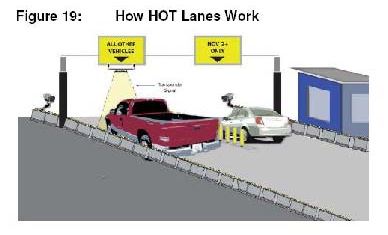Also discussed here: HOT Lanes: A Better Way to Attack Urban Highway Congestion (Robert W. Poole Jr. and C. Kenneth Orsk, CATO Institute)
And here: 2014 Ontario Budget Passes in Legislature - Plan Will Create Jobs, Build Modern Infrastructure and Transportation, Enhance Retirement Security (Press Release, Ontario Ministry of Finance, Jul. 24, 2014)
And here: Budget 2014 Building Modern Infrastructure (9 page pdf, Ontario Ministry of Finance, May 1, 2014)
And here: 495 Express Lanes Usage Update - July 2014 And here: Metrolinx: HOT lanes should be used to break the ice for VMT charging (Grush Hour, Apr. 18, 2013)
Today, we review a paper that was written 14 years ago but is still highly relevant in today’s world of congested urban highways that are getting worse, in the US and Canada at least. The authors review the state of car-pool or transit-only lanes (or high occupancy lanes as the transportation planners dub them), conclude that these lanes tend to be underused and are ineffective and point out the advantages of converting that the HOV lane to a HOT lane which introduces supply and demand pricing to the argument. Given also the great pressure for politicians against introducing any tolls but the equally great pressure to generate revenue and lower taxes, HOT lanes seem inevitable.
One must think that the government in Ontario is thinking along the same lines as they propose HOT lanes for all 400-series highways in the province, included in the May 1, 2014 budget and repeated in a budget bill that received Royal Assent on Jul. 24, 2014 as part of the “economic tools” to pay for over $30B needed for public transit over the next 20 years. A first step to more comprehensive road and congestion pricing perhaps?

Key Quotes:
“High-Occupancy Vehicle (HOV) lanes were once seen as innovative and beneficial, the idea being that they would encourage carpooling and thereby reduce highway congestion and air pollution. But opposition to HOVs is spreading “
“Irate drivers see hov lanes as an inefficient use of scarce road space. They claim that few drivers take advantage of carpool lanes, while thousands of solo commuters must endure stop-and-go traffic in adjacent general-purpose lanes.”
“Because a freeway lane has a smooth-running capacity of 1,500-1,800 vehicles an hour, an hov lane must carry at least 700-800 vehicles an hour in order to offer equivalent “person throughput,” at an average of 2.1-2.2 persons per vehicle.”
“we are not tolling HOV lanes. There is an expansion of HOV lanes. The system of HOT lanes does not diminish by one car the access to the entire system, including the HOT lanes, for people who have more than one vehicle….Metrolinx has carefully planned out which routes are optimal. Metrolinx can actually tell you that the price per kilometre is 47 cents. .. very successful HOT lanes across North America are used mostly by people with under $60,000 income, that it’s been a benefit to middle-income families, especially moms who are trying to get their kids to school. It’s a very cost-effective option, and it’s had a significant impact on reducing congestion. This is hardly something used by only affluent people, and it has not compromised the role of HOV lanes one iota” (Hon. Glen R. Murray, Ontario Minister of Transportation and Infrastructure, Legislative Debates, May 14, 2013)
“HOT lanes can be established rather inexpensively by placing electronic toll booths in existing HOV lanes, alongside the travel lanes or in the medians of highways.”“Data from existing HOT lanes projects indicate that people at all income levels use the lanes when saving time is important to them.”
“A hot lanes project may meet one of these four objectives:
- Absorb unused capacity on an existing hov lane.
- Absorb extra capacity arising from a switch from hov-2 to hov-3.
- Relieve congestion on a highly congested freeway.
- Manage traffic on a new limited-access highway."
"The cost of converting an existing hov lane to a hot lane is relatively low. The main capital expenditures are for plastic pylons, changeable message signs, gantries, toll-reading and video-enforcement equipment, and computer hardware and software.”
“hot lanes yield other general benefits:
- They reduce congestion in adjacent general-purpose lanes.
- Transit vehicles gain access to faster-moving lanes, which entices some commuters to switch from autos to express buses or commuter-shuttle vans.
- Further, toll revenues can be used to provide express bus service, as San Diego is doing in its I-15 hot lane corridor.
- Emergency vehicles can reach their destinations much more quickly on hot lanes.
- And, unlike general-purpose highways and hov lanes, only the users of a hot lane facility pay for it.”
“New Dedicated Funds for Investment in Transportation Infrastructure…Dedicating net revenue gains from high-occupancy toll lanes when they become available"[2014 Ontario Budget]




No comments:
Post a Comment